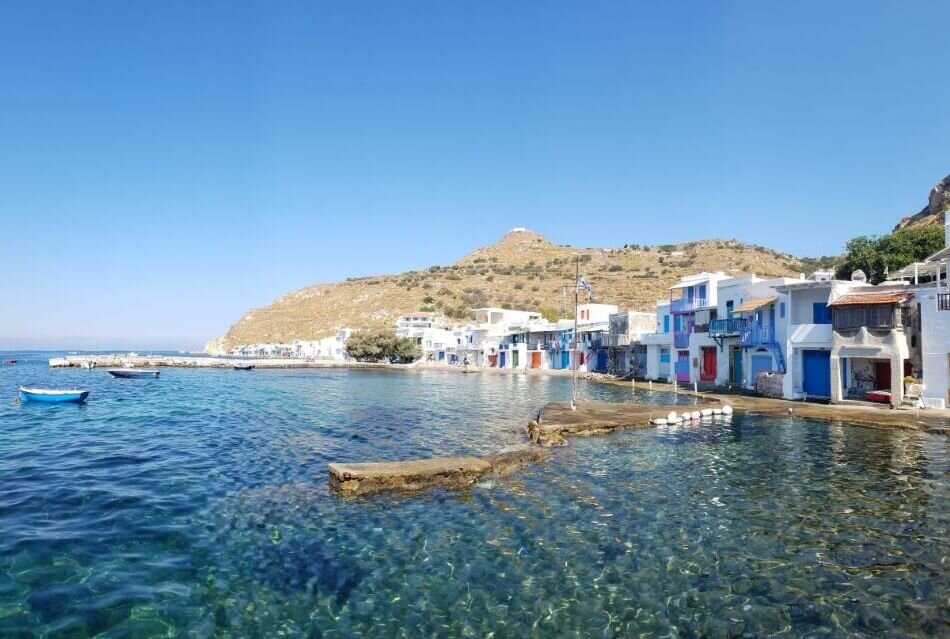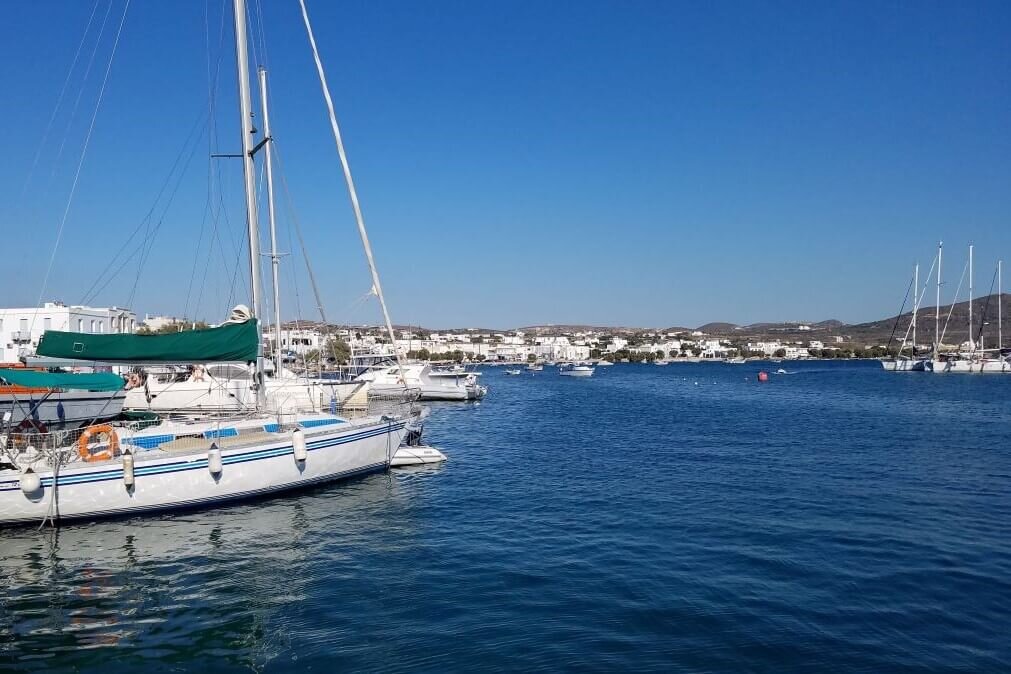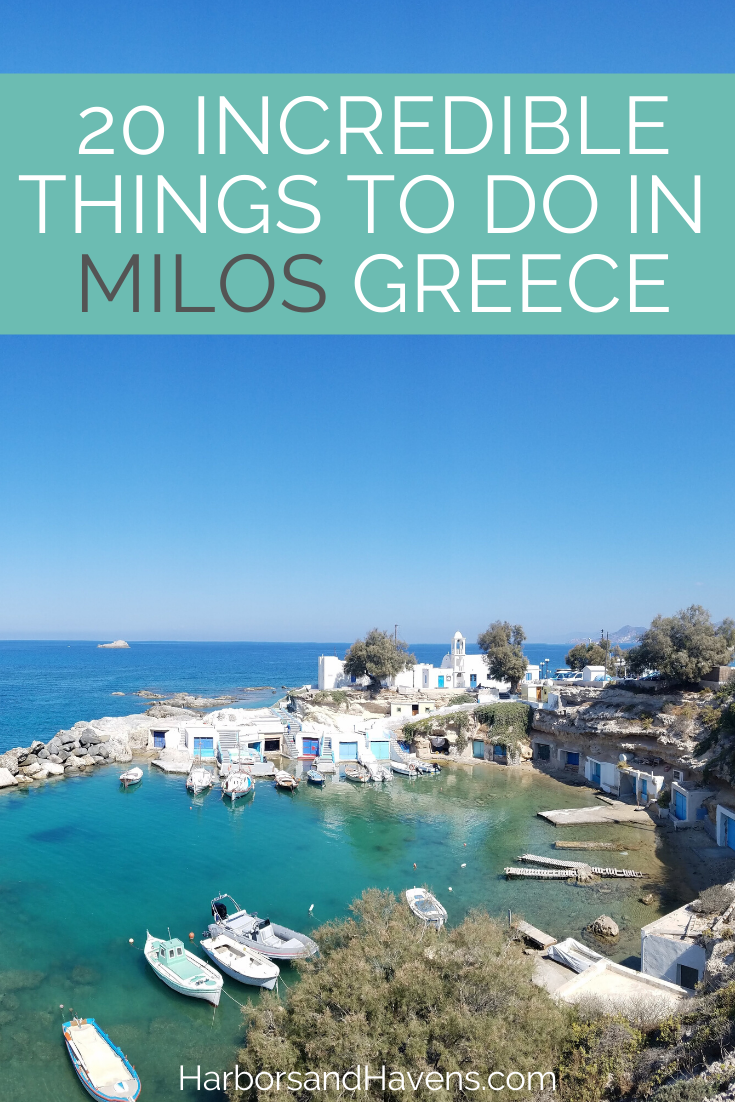20 of the Best Things to Do in Milos Greece This Summer
Looking for the best things to do on Milos, Greece? This Milos bucket list and guide will help you plan an epic vacation to the Greek island.
Sparkling turquoise waters, incredible sea caves, picture-perfect fishing villages — Milos island is a must-see in the Cyclades. If you’re looking for things to do in Milos, Greece, this bucket list full of natural attractions, beaches and whitewashed towns will get you started.
With a mining legacy dating back thousands of years, this volcanic island in the Aegean Sea attracts visitors to its unique rock features like the lunar landscape of Sarakiniko Beach and salt-splashed tunnels at Kleftiko bay. The beauty of the sands here surrounded by red and yellow-hued cliffs earn the island a reputation for hosting some of the most striking beaches in the world.
This Milos travel guide will help you discover it all, from what to do in Milos to tips for your trip and ideas on where to stay. Get ready to fall in love with this Greek island vacation!
Top Things to Do in Milos Greece
Plan out the best things to do in Milos using this map of attractions and beaches. We’ve rounded up the best spots to put on your Milos bucket list below.
Sykia Cave Boat Tour
A popular stop on boat tours of Milos, Sykia Cave is situated on the western tip of the island. Entrance from the sea via a small opening leads into the cavern, where you’ll quickly spot a unique feature above — the open roof.
Once covered, the rock ceiling here crumbled, and sunlight now floods the lagoon, dancing on the water and giving it emerald hues.
Large vessels don’t fit in the cave, so boat excursions drop passengers off just outside to swim or row in. A small, gravely beachfront and some huge boulders offer lounging and resting spots.
Kleftiko Boat Tour
One of the most photographed natural attractions and best things to do in Milos, Kleftiko sits on the southwest end of the island. The perfectly clear, turquoise water of this cove competes as the main attraction with a number of intriguing rock formations with tunnels and caves.
You’ll want to both stare in dumbstruck awe and jump in immediately to float through stone arches and dip under the surface in search of swimming critters. This is a fun spot to go snorkeling, and you can swim through the arches and caves.
Paliochori Beach
South coast Paliochori Milos is one of the more popular and organized beaches on the island. Towering rocks with streaks of red back a long stretch of gritty, tan-hued sand here, while mineral springs just offshore create pockets of warmth in the clear water.
The amenities are what make this one of the best beaches on Milos to spend the day, with a few cafes as well as sunbed and water sports vendors. There are also quite a few zones to spread out along the coast here, so wander around the rocks until you find an appealing spot.
Firiplaka Beach
A long stretch of sandy shoreline backed by soaring cliffs splashed in shades of yellow, red, pink and white paints the scene on the south coast. The water here is perfectly clear with a pebbly floor in some areas and a sea stack that adds to the photo-perfect setting.
With lots of places to lay down a towel and calm, shallow water to play in, this spot is perfect for a beach day. Facilities and amenities aren’t available, though, so bring your own snacks and shade if you need it.
The dirt road leading to Firiplaka is easy and safe to drive, and there are some obvious parking areas and wide shoulders toward the end of the path. You’ll have to make your way downhill to reach the beach, but it’s not terribly difficult.
Hanging out at this quiet beach was one of my favorite things to on Milos.
This 5 day Greece vacation plan includes ruins in Athens and adventures in Milos.
Provatas Beach
This sandy south coast beach sits on a big bay with easy access just off the main road. Soft, almond-hued shoreline leads into crystal-clear shallow waters ideal for swimming.
Beach rentals are available here and a couple of eateries are nearby. A small parking area is a few steps up from the shore and a bus stop nearby.
Tsigrado Beach
Situated in a cove with a secluded feel, this small patch of sand is surrounded by soaring cliffs, sea caves, and of course, sparkling turquoise waves.
It takes some work to get down to the water from the bluff above — a narrow crevice has some wooden steps and rope to help beachgoers up and down. While the setting is private due to the effort to reach it, the lounging area is pretty tiny and can fill up quickly.
Tsigrado is quite near Firiplaka at the end of the same dirt road along the mid-south coast of Milos.
Paliorema Old Sulfur Mine
The old sulfur mine at Paliorema is what sets this Milos beach apart. Behind the sandy seafront, abandoned buildings and rails sit in ruins, built into the colorful cliffs from which they harvested minerals.
Aside from sea access, the only way to reach the site is via dirt roads more conducive to four-wheel drives and ATVs. While some people bring their vehicles all the way down to the shore, doing so is risky. You might want to park before the road drops and walk the rest of the way. There are no facilities or amenities at this beach.
Sarakiniko
Smooth rock surfaces in a chalky white give Sarakiniko beach what’s often described as a lunar look. The volcanic surfaces shaped by the wind and salty sea form ridges, humps, sheer cliffs and coastal caves. Visiting this beach is one of the most popular things to do in Milos!
The most accessible spots flow gently into the sea, polished by the waves, and serve as lounging spots for sun-seekers. While the shoreline along a narrow inlet of ocean leading to a sandy beach tends to draw most of the swimmers and snorkelers, there are plenty of breathtaking landscapes to explore in either direction along the rocks, and the Sarakiniko shipwreck to the right from the end of the entrance trail.
Located on the north coast, an easy 10-minute drive from Adamas, Sarakiniko has plenty of parking and a bus stop.
Papafragas Cave
Unlike Sykia and Kleftiko, this northern coastal cave is easily accessible by land — at least from the top, where you can stare down into long, cyan-sea filled hole surrounded by cliffs. To actually explore inside requires a steep climb down the rocks (lots of warning signs are posted here) to the tiny Papafragas Beach.
Pollonia
A quiet seafront alternative to the main tourist port of Adamas, Pollonia on the northern tip of the island is worth a visit even if you don’t stay here. With a meld of fishing village and family resort vibes, the town offers a waterfront zone of shops and restaurants and a wide swath of beach on a cove where small watercraft dot the waves.
It’s a great spot for a beach day with shade, thanks to a host of trees and umbrella loungers on the sand. There’s also access to boat trips from here.
Parking is available in a large lot just outside of town, and the bus stops here as well.
Firopotamos Beach and Town
A pocket-sized village, sandy beachfront, and clear water sheltered by a bay can all be found at Firopotamos on the northern coast. A classic white church sits overlooking a handful of colorful-fronted syrmata, or boat garages, with apartments above.
All of this is visible from the dust-colored beach dotted with shade trees. Amenities are limited (a snack and chair vendor is on-site) and a small parking area is available downhill from the road by the beach.
Mandrakia and Tourkothalassa Beach
With colorful boat garages ringing a tiny aquamarine cove on the north coast of Milos, the fishing village of Mandrakia makes for a postcard-perfect picture. There’s only one restaurant and a few vacation rentals here, so it’s pretty quiet and uncrowded.
The syrmata here are built into the rocky cliff, with wooden doors painted mostly in shades of blue and vessels bobbing on the sea’s surface. Atop the bluff, a small white church gazes down on the scene.
There’s not much to do here but sit and soak up the views, but there are plenty of rocky surface around the town to lay out under the sun and clear water for swimming. About a 5-minute walk from the village, pebbly Tourkothalassa Beach offers a spot to wade in with views of Mandrakia.
Paved parking is available just a few steps from town.
Ancient Theater of Milos
Built by the Romans sometime between the 1st to 4th centuries and once adorned in marble, the ancient theater in Milos is one of the best-preserved in the Cyclades. A traveling monk discovered the site in the 1730s, and later excavations uncovered the semi-circle auditorium with seating and an arena that visitors can walk around today.
The theater sits high on a slope overlooking the sea above the tiny town of Klima. A parking area shared with the catacombs is just a 10-minute walk away. Along the path, you’ll pass a sign marking the spot where the famous Hellenistic-era “Venus de Milo” statue was uncovered a couple of centuries ago (she’s now on display in the Louvre Museum in Paris).
This is one of the coolest things to do in Milos if you’re interested in Greek history.
Catacombs of Milos
Both an ancient burial site and a refuge from persecution by the Romans, the Milos Catacombs are considered one of the most significant monuments of early Christian worship in Greece. The underground complex dates to the 1st century and is located near the ancient theater below the village of Trypiti.
For a small fee, visitors can access a few of the chambers and see wall inscriptions and graves. A designated parking area is nearby. The catacombs are a must-see for your Milos bucket list if you’re into ancient Greek history.
Klima
The old fishing village of Klima consists of just a couple of tiny shops and cafes, but the rainbow of colors and sunsets here make it worth a visit. A row of simple white homes nestles snuggly between a rocky hill and encroaching waves, their boat garages, doors and balconies painted in coordinating shades to distinguish one from the other.
Located on the Milos Bay below the town of Trypiti, the seafront was once a thriving harbor in ancient days. Though the present-day village has mostly been abandoned (a shop-owner said just a handful of people live there), a few of the apartments serve as vacation rentals.
Parking is on the roadside as you approach the town and the nearest bus stop is in Trypiti about a mile away and uphill from Klima.
Trypiti
The winding streets of hillside Trypiti look down toward the sea on a part of the island rich in history. Within the town is an array of shops and restaurants, some with coastal views, a huge white church with dual bell towers, and a few windmills transformed into vacation rentals.
Walk down toward the waterside fishing village of Klima and you’ll encounter a couple of ancient landmarks — the Catacombs of Milos archeological site, where you can tour the underground complex used by early Christians, and the well-preserved Roman amphitheater.
Plaka Town and Plaka Castle
Full of whitewashed buildings with blue shutters, stone-paved alleys, and ivy and blooms adding pops of color, Plaka ticks off the picturesque bucket list for a Cyclades town. Its elevated hilltop position also means sweeping views of the gulf of Milos and the sea beyond.
Within the pedestrian zone of the village, you’ll find an assortment of cafes and shops, while a few museums scattered about town covers themes of history and culture. Wander toward the church with two bell towers for a stunning open view of the coast from the patio outside.
Built atop one of the highest peaks in Milos, the Plaka Castle sprung up during the Venetian occupation of the island in the 13th century. You can ascend the hill to see the ruins of the Venetian Castle of Milos and a couple of old churches along the way. At the top is a small white church called Mesa Panagia and a courtyard that offers 360-degree views of the island.
Archeological Museum of Milos
Located in Plaka, the Archeological Museum of Milos houses a small collection of historically significant pieces found on the island. Some displays come from excavations around the Bronze Age settlement of Phylakope and the ancient theater, including a headless female statue made from marble dating to 100 B.C.
There is also a copy of the famous “Venus de Milo” statue since the real one is in the Louvre. The original piece thought to depict the Greek goddess Aphrodite was crafted sometime around 100 B.C. and found on Milos in 1820.
There is a small entry fee for the museum.
Adamas/Adamantas
The island’s port city and a center of commerce, Adamas (or Adamantas) brims with traditional white buildings on land and fishing boats and catamarans in the harbor. Ferries and the occasional cruise ship dock here, so the streets near the water have a healthy supply of shops and open-air restaurants.
It’s one of the most popular places to stay in Milos and you’ll find lots of car and ATV rental centers as well as a bus stop. Many of the Milos boat tours also take off from here to explore the western and southern coasts of the island.
Milos Mining Museum
After spending some time exploring the incredible natural features of Milos in the great outdoors, pay a visit to the Milos Mining Museum to learn more about the island’s geological history. Mining plays a huge part in Milos’ legacy and culture, dating back millenniums. The museum displays mineral samples found here like obsidian and sulfur, as well as topographical maps and old tools.
The museum is located in Adamas, just a short walk from the port area and charges a small fee.
Tips for Visiting Milos
1. Rent a vehicle. While public buses do serve many of the most popular attractions, a personal vehicle is most useful for exploring at your own pace and discovering things to do in Milos at hidden beaches and coves. The rental providers will show you which roads are most accessible and which you can travel at your own risk. Choosing a four-wheel-drive is helpful for the many dirt and rocky paths.
3. Wear sunscreen. The summer sun is brutal (and wonderful) in Milos, and if you’re spending a lot of time outdoors and the many beaches, you’ll want to protect your skin. While you can buy it from the general stores here, it’ll likely be cheaper to bring your own from home.
This what to pack for Greece guide will give you pointers for what else should be in your suitcase for a trip to Milos.
5. Be flexible with ferries. Ferries in Greece are fantastic for getting around to the different islands, but they aren’t always reliable. Be aware that they may run late, be canceled, or go on strike and plan to be flexible with your schedule.
Where to Stay in Milos
You can learn more about the different towns and types of hotels in this guide for where to stay on Milos.
Adamas
While it’s the most buzzing town as the main transit hub, it’s far from crowded, and you’ll see locals hanging out near the town square and kids riding their bikes.
Plaka and Trypiti
The neighboring hillside towns of Plaka and Trypiti are just a 10-15 minute drive from Adamas, but their elevated location means views from some accommodations. Both have hotels and apartments to rent, and plenty of cafes within walking distance.
Pollonia
How to Get to Milos
Milos has a small airport with direct flights to and from Athens that take less than an hour. Ferries lines connect to popular ports like Piraeus (Athens) and Santorini. The Athens trip can be as quick as about 3 hours, and the Santorini one around 2 hours. The fastest rides are typically on high-speed, passenger-only catamarans.






















